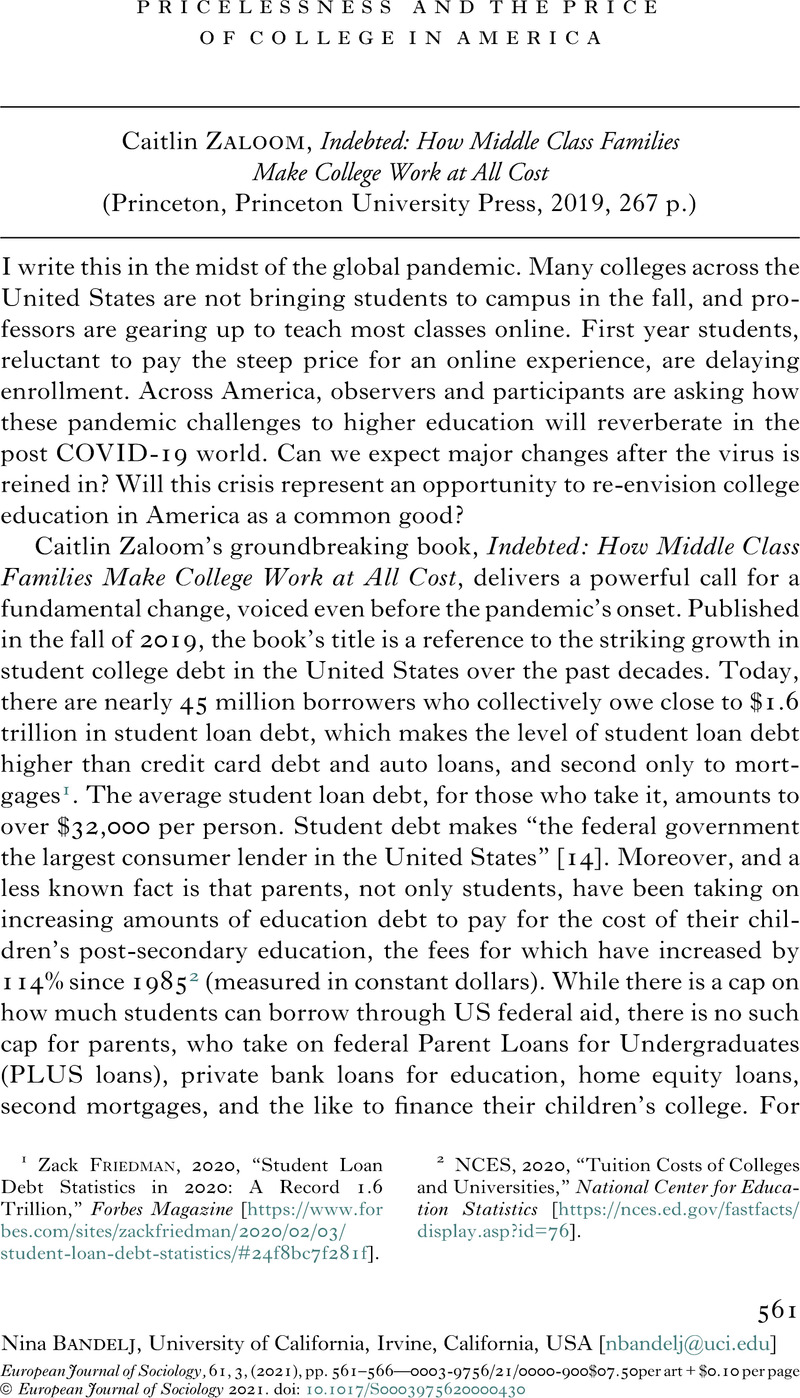No CrossRef data available.
Article contents
Pricelessness, and the Price, of College in America - Caitlin Zaloom, Indebted: How Middle Class Families Make College Work at All Cost (Princeton, Princeton University Press, 2019, 267 p.)
Published online by Cambridge University Press: 26 March 2021
Abstract

- Type
- Book Review
- Information
- European Journal of Sociology / Archives Européennes de Sociologie , Volume 61 , Issue 3 , December 2020 , pp. 561 - 566
- Copyright
- © European Journal of Sociology 2021
References
1 Friedman, Zack, 2020, “Student Loan Debt Statistics in 2020: A Record 1.6 Trillion,” Forbes Magazine [https://www.forbes.com/sites/zackfriedman/2020/02/03/student-loan-debt-statistics/#24f8bc7f281f]Google Scholar.
2 NCES, 2020, “Tuition Costs of Colleges and Universities,” National Center for Education Statistics [https://nces.ed.gov/fastfacts/display.asp?id=76]Google Scholar.
3 Fass, Paula, 2016, The End of American Childhood (Princeton NJ, Princeton University Press)CrossRefGoogle Scholar.
4 Nomaguchi, Kei and Milkie, Melissa, 2019, “What Should Children Learn? Americans’ Changing Socialization Values, 1986-2018,” Socius: Sociological Research for a Dynamic World 5: 1-17CrossRefGoogle ScholarPubMed.
5 Ishizuka, Patrick, 2019, “Social Class, Gender, and Contemporary Parenting Standards in the United States: Evidence from a National Survey Experiment,” Social Forces, 98 (1): 31-58CrossRefGoogle Scholar.
6 Schneider, Daniel, Hastings, Orestes P. and LaBriola, Joe, 2018, “Income Inequality and Class Divides in Parental Investment,” American Sociological Review, 83 (3): 475-507CrossRefGoogle Scholar; Doepke, Matthias and Zilibotti, Fabrizio, 2018, Love, Money and Parenting: How Economics Explains the Way we Raise our Kids (Princeton NJ, Princeton University Press)Google Scholar.
7 Zelizer, Viviana, 2010, Economic Lives: How Culture Shapes the Economy (Princeton NJ, Princeton University Press)Google Scholar.
8 Page 7, in Bandelj, Nina, Wherry, Frederick and Zelizer, Viviana, 2017, Money Talks: Explaining How Money Really Works (Princeton NJ, Princeton University Press)Google Scholar.
9 Zelizer, Viviana, 1985, Pricing the Priceless Child (New York, Basic Books)Google Scholar.
10 Edward N. Wolff, 2010, “Recent Trends in Household Wealth in the United States: Rising Debt and the Middle Class Squeeze-An Update to 2007,” Levy Economics Institute (Working Paper, 589).
11 Western, Bruce, Bloom, Deirdre and Percheski, Christine, 2009, “Inequality among American Families with Children, 1975 to 2005,” American Sociological Review, 73 (6): 903-920CrossRefGoogle Scholar; Gibson-Davis, Christina and Percheski, Christine, 2018, “Children and the Elderly: Wealth Inequality Among America’s Dependents,” Demography, 55 (3): 1009-1032CrossRefGoogle ScholarPubMed.
12 Seamster, Louise and Charron-Chénier, Raphael, 2017, “Predatory Inclusion and Education Debt: Rethinking the Racial Wealth Gap,” Social Currents, 4 (3): 199-207CrossRefGoogle Scholar.




